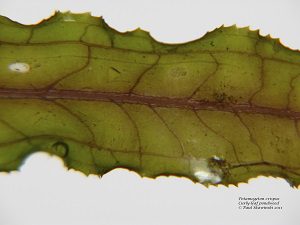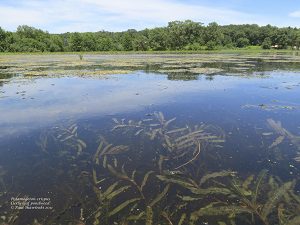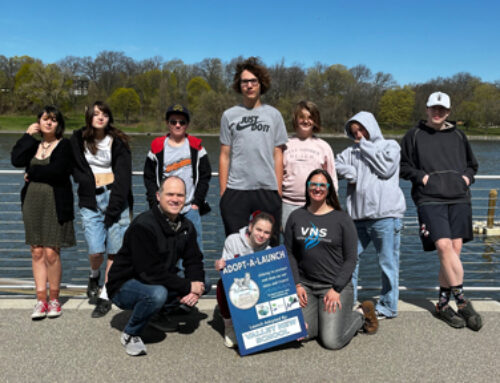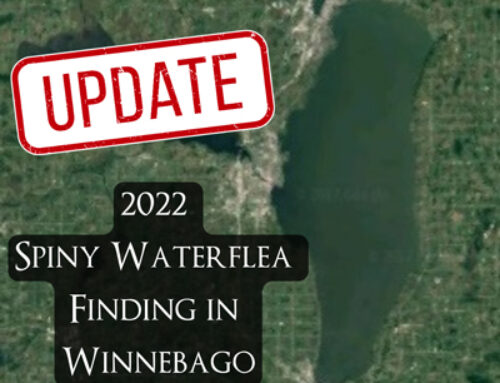Every month, we will put a spotlight on an aquatic invasive species in a re-occurring monthly article. Check it out!
Curly-leaf Pondweed – Lasagna Noodles on a Plant?
Curly-leaf pondweed (Potamogeton crispus) is native to Africa, Australia, and Eurasia. It was likely introduced as a contaminant through fish stocking programs and aided in its invasion by aquarium releases. First documented in Wisconsin in 1905, it has spread to over 730 lakes and rivers in Wisconsin.
Curly-leaf pondweed (CLP) is a completely submersed plant that roots in the bottom of lakes. It’s most distinctive feature is the wavy, lasagna-like leaves that  grow attached to the stem of the plant. Leaves have serrated edges and blunt tips that differentiate it from the native clasping-leaf pondweed. The leaves alternate on the stem and grow two to three inches long. CLP tends to grow to up to the water’s surface and may create a dense mat of plants at the surface of the water. The plant does produce a flower above the surface, typically in June. CLP creates turions, a reproductive structure that looks like a smaller pinecone. Turions detach from the parent plant and remain dormant at the bottom of the waterbody. As water temperature drop in the Wisconsin fall, the turions start to grow
grow attached to the stem of the plant. Leaves have serrated edges and blunt tips that differentiate it from the native clasping-leaf pondweed. The leaves alternate on the stem and grow two to three inches long. CLP tends to grow to up to the water’s surface and may create a dense mat of plants at the surface of the water. The plant does produce a flower above the surface, typically in June. CLP creates turions, a reproductive structure that looks like a smaller pinecone. Turions detach from the parent plant and remain dormant at the bottom of the waterbody. As water temperature drop in the Wisconsin fall, the turions start to grow  a new plant that survives the winter as an intact plant with leaves. CLP can stay alive underneath ice and snow and might even be growing under the ice today! As soon as water temperatures get above ~50°F, the plant can grow 3-4 in./day. This gives CLP a significant advantage in the spring as it can start growing earlier and faster than native plants.
a new plant that survives the winter as an intact plant with leaves. CLP can stay alive underneath ice and snow and might even be growing under the ice today! As soon as water temperatures get above ~50°F, the plant can grow 3-4 in./day. This gives CLP a significant advantage in the spring as it can start growing earlier and faster than native plants.
CLP can outcompete native plants for space and light early in the growing season, altering plant diversity. While the plant can provide habitat for fish and other species in the early part of the year when other plants are not present, CLP tends to dominate systems in the spring. Water flow is often then impeded resulting in stagnant  water areas. When the plant dies back in the early part of the summer, the large release of nutrients stored in the plant can help fuel algae blooms. Oxygen is also used as CLP is decomposed which can drop the oxygen levels so dramatically that there is not enough oxygen in the water for fish causing fish kills. As recreation on waterways begins in the early spring/summer when CLP is dominating the system, boating, fishing, and other activities can be negatively impacted. The large surface mats of the plant can make these activities difficult. The aesthetic value of shoreline properties can also decrease with large mats of CLP.
water areas. When the plant dies back in the early part of the summer, the large release of nutrients stored in the plant can help fuel algae blooms. Oxygen is also used as CLP is decomposed which can drop the oxygen levels so dramatically that there is not enough oxygen in the water for fish causing fish kills. As recreation on waterways begins in the early spring/summer when CLP is dominating the system, boating, fishing, and other activities can be negatively impacted. The large surface mats of the plant can make these activities difficult. The aesthetic value of shoreline properties can also decrease with large mats of CLP.
CLP is classified as a Restricted Species in all counties across the state of Wisconsin.
And no, it doesn’t taste like lasagna.
Want to help? HELP PREVENT THE SPREAD!
Every time you come off the water, make sure to follow these steps to stop the spread of faucet snails and other aquatic invasive species:
* Inspect boats, trailers, push poles, anchors, and other equipment for attached aquatic plants or animals.
* Remove all attached plants or animals
* Drain all water from boats, motors, livewells and other equipment
* Never move live fish away from a waterbody
* Never release aquarium plants or animals into your local waterways
Follow the Fox Wolf Watershed Alliance’s Winnebago Waterways Program on our Winnebago Waterways Facebook page or @WinnWaterways on Twitter! You can also sign-up for email updates at WinnebagoWaterways.org.
Questions? Comments? Contact Chris Acy, the AIS Coordinator for the Winnebago Waterways Program covering Fond du Lac, Calumet, and Winnebago Counties at (920) 460-3674 or chris@fwwa.org!
Winnebago Waterways is a Fox-Wolf Watershed Alliance program. The Fox-Wolf Watershed Alliance is an independent nonprofit organization that identifies and advocates effective policies and actions that protect, restore, and sustain water resources in the Fox-Wolf River Basin.
Photo Credit: Paul Skawinski





